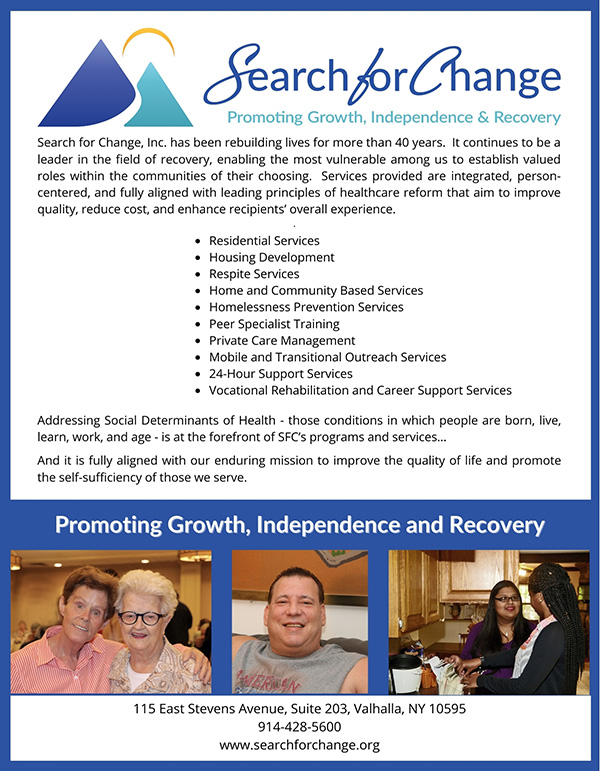In recent years it has become commonplace to reference “transformational” initiatives within our health and social service systems that have altered the manner in which care is delivered and reimbursed. A movement to replace “Fee-for-Service” models with “Value-Based” alternatives purports to bend an intractable cost curve that has defined the American healthcare system. An emergent recognition that Social Determinants of Health (SDoH) are dispositive of health outcomes (considerably more so than the quality or accessibility of healthcare and health-related services) has influenced the priorities of providers and payors alike. Authority over the publicly funded healthcare system continues to devolve from statehouses to the boardrooms of privately owned and operated payors, most of which operate under “Managed Care” arrangements with profound implications for their contracted providers and service recipients. The list continues. Perhaps none of these trends, however, has disrupted our systems of care as significantly as the sudden emergence of alternative methods of service delivery necessary to ensure public safety during the COVID-19 pandemic.

Ashley Brody, MPA, CPRP
These methods couched under the overarching rubric of “telehealth,” surely are not new, but they have been deployed on an exponential scale and all but upended our service delivery system. As the Chief Executive Officer of one telehealth company quipped, “There are generations when nothing happens. There are decades when nothing happens. And there are weeks when decades happen. And that’s exactly what we’ve gone through.” (Pifer, 2020). This latest transformation was enabled through a substantial relaxation of regulatory constraints that precludes the delivery of healthcare services via remote means under most circumstances. A byzantine patchwork of state and federal regulations has effectively relegated telehealth to the role of “exception to the rule,” at least until recently. As the pandemic exerted its full force and effect in early 2020 and providers scrambled to deliver primary and behavioral healthcare services to vulnerable individuals (many made more so by the Coronavirus and its disproportionate impact on individuals with chronic and comorbid health conditions), telehealth quickly emerged as a means to mitigate risk while ensuring continuity of service delivery. Its widespread adoption also received nearly universal support from the provider community whose members experienced rapidly dwindling margins as traditional (i.e., “in-person”) service volume evaporated.
The proverbial “barn door” to telehealth has been pushed open. Whether and to what extent it closes again will be subject to protracted debate among innumerable stakeholders in the months, and possibly years, to come. Questions whose answers remain elusive abound. Are services delivered remotely comparable in quality to those delivered via traditional means? Providers presumably incur fewer costs in delivering services remotely, so this should produce savings that accrue to payors and the general public. But will it? That is, will savings be realized or will the relative ease with which services may be delivered remotely lead to increased utilization and associated costs? Can patient confidentiality and privacy protections be assured amidst myriad videoconferencing platforms, a rapidly changing array of originating and distant sites, and enduring vulnerabilities in providers’ Information Technology (IT) infrastructures? Will the extensive use of telehealth align with and support other transformative initiatives presently underway (e.g., Value-Based Care) to which the industry has already committed considerable resources?
To invoke another frequently used (and arguably hackneyed) metaphor, the telehealth “plane” will be “built as it’s flying,” and answers to the foregoing questions must be answered in flight. And there are additional considerations and potential unintended consequences of this movement that should guide the plane’s trajectory. For example, although our traditional modes of care are fraught with deficiencies, we now possess a wealth of information with which to direct quality improvement initiatives applicable to conventional care (many of which are already in effect and inform value-based contracting and delivery activities). A dearth of evidence concerning the efficacy of telehealth as a substitute for (or supplement to) conventional care could easily lead to a misallocation of scarce resources or impede providers’ progress in achieving desired outcomes. In the event telehealth proves inferior by some measures it could be especially deleterious to individuals with behavioral health and chronic or comorbid physical health conditions, the economically disadvantaged, and other exceptionally vulnerable populations for which traditional healthcare, with its known and proven benefits, has often been ineffective. Moreover, disparate treatment of (and reimbursement for) primary and behavioral health treatment persists despite legislation designed to prevent it. Such disparities might deepen as a “digital divide” deprives many individuals of the reliable and affordable broadband technologies necessary to access healthcare services remotely. The senior and low-income populations, many of whose members are at greater risk of adverse outcomes associated with chronic, comorbid, or poorly managed health conditions, would be especially vulnerable to the digital divide should telehealth remain prevalent. Little more than half of Americans aged 65 or older own a smartphone or have broadband access, and low-income individuals have similarly low rates of smartphone ownership and broadband or internet access (Smith, 2020). Thus, policies that aim to codify telehealth as a permanent alternative or supplement to traditional modes of care must account for enduring disparities, lest the safety and “convenience” of remote care prove to be anything but for the less fortunate among us.
There is cause for guarded optimism despite the perils and inevitable disruptions that attend another “transformation” within the healthcare industry. The Governor’s Executive Budget Proposal contains certain provisions that, if enacted, would enhance recipients’ access to essential technologies and promote insurance coverage for services delivered remotely (Reimagine New York Commission, 2021). At the federal level, the Medicare Payment Advisory Commission (MedPAC) has indicated its willingness to grapple with various complexities and competing interests that accompany the expanded use of telehealth within the Medicare program. For instance, Commissioners have recognized the importance of “audio-only” (i.e., telephonic) technologies for individuals who lack broadband access necessary to support videoconferencing, but they have also acknowledged potential deficiencies in such technologies that merit further exploration lest they compromise the quality of care delivered to vulnerable individuals (Liss, 2020). The MedPAC has also recognized telehealth has significant implications for patient privacy and confidentiality that must be properly reconciled alongside imperatives to expand access.
The digital transformation will undoubtedly generate its share of “winners” and “losers,” and its impact on disparate populations might not be fully realized for years to come. Policymakers, regulators, and other key stakeholders must give serious consideration to the needs of the most vulnerable among us in order for this transformation to align with and support others presently underway. True “value” in healthcare cannot be achieved unless it extends to disadvantaged and marginalized populations. Economy and equity demand nothing less.
The author, Ashley Brody may be reached at (914) 428-5600 (x9228), and by email to abrody@searchforchange.org.





